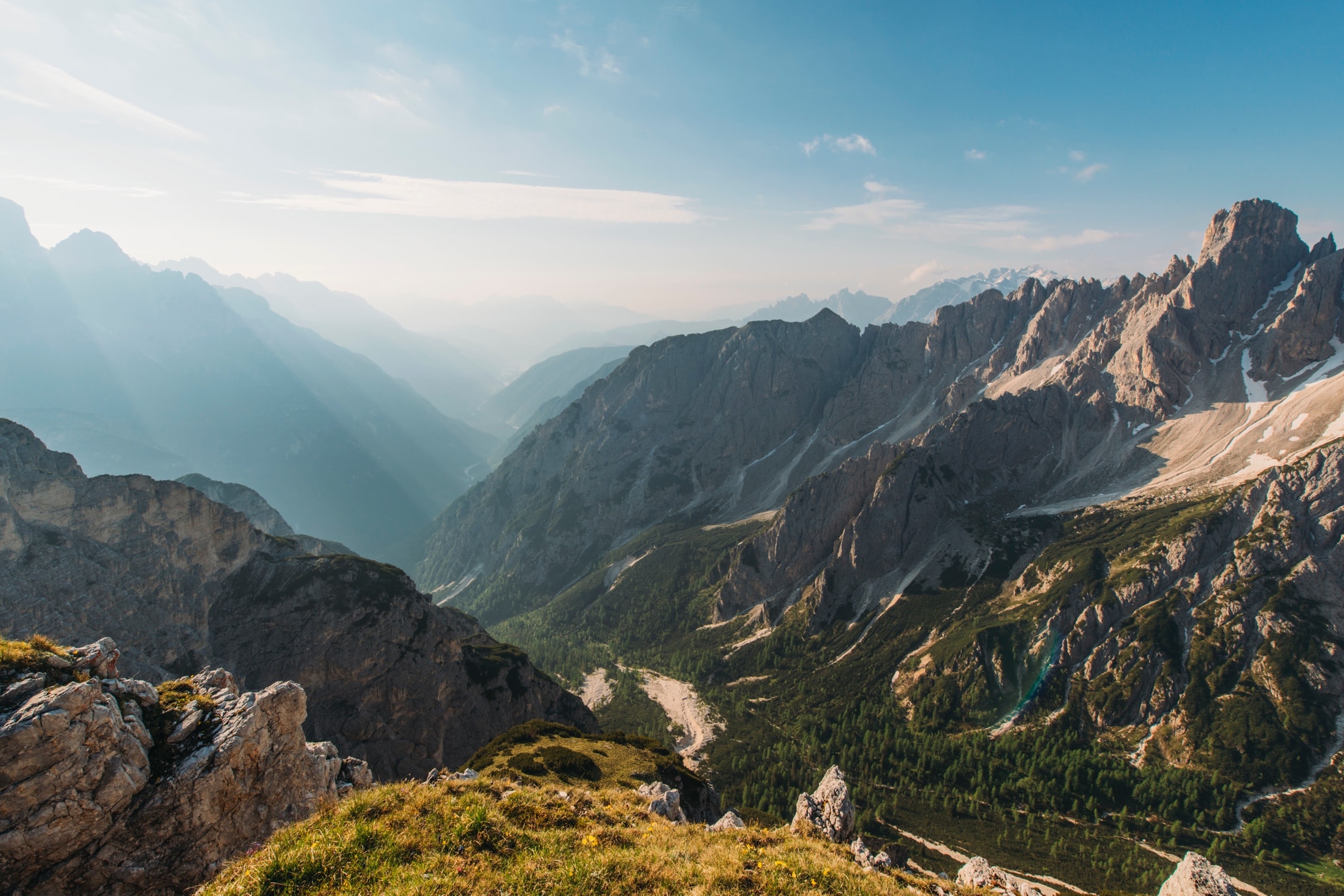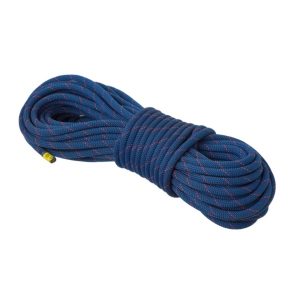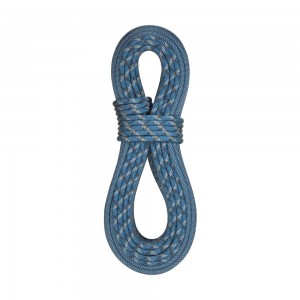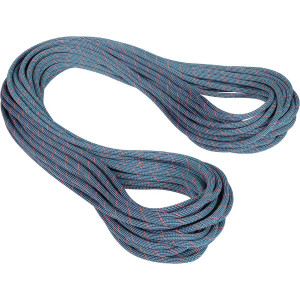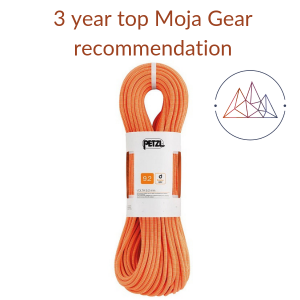At the heart of every climber’s gear closet hangs a climbing rope. But buying a climbing rope can be an overwhelming task. REI alone carries over one hundred different climbing ropes. How can you possibly make the right choice with so many options?
Don’t worry! Moja Gear has sorted through the top 49 selling models of 2019 to give you the best recommendations for each category of climbing.
Find the top recommendations for best gym climbing ropes, durable climbing ropes, sport climbing ropes, trad climbing ropes, and half/twin ropes.
Recommendations are unbiased, based on personal experience and community reputation. Your purchases support our free content.
Get our climbing newsletter for a weekly dose of kickass content and check out our deals page for today’s best sales.
Best gym climbing ropes
Climbing ropes specifically designed for indoor climbing have become popular in recent years. Gym ropes tend to be 30-40 meters in length and are convenient for use in indoor settings, where walls do not reach a height that would require a full-length rope. Thus, with a gym rope, you have less rope to manage and you can spare your longer ropes from the wear and tear of indoor climbing.
If buying a gym rope, you may also consider going in with a friend to purchase a full-length (generally 70m) rope and having it cut in half (most gyms have a hot knife to do this). Double-check with your gym to determine the necessary rope length for their walls.
Best durable climbing rope for indoor climbing, top-rope climbing, and new outdoor climbers.
Indoor routes are typically not higher than 50 feet, so the weight of the rope is less significant. Indoor climbing is all about training, so a durable rope that will hold up to frequent use will keep your costs down. The weight of a durable climbing rope can actually be helpful in an indoor training environment because you will feel even better when you take your lightweight rope outdoors.
Thick climbing ropes provide excellent durability, especially for climbing styles that put excessive wear on the rope (such as repeated falls on a hard sport climb, climbs where the rope is rubbing against the rock, or top-roping, where the rope is continuously sliding against the upper anchors).
Ropes with a diameter of 10.0 mm or larger are considered large diameter climbing ropes. The tradeoff for their strength and durability is the higher weight and higher stiffness of the rope. The higher stiffness makes handling a bit more difficult. You will notice that the larger ropes require more effort to tie your knots and run through your belay device.
Conversely, medium thickness ropes have the advantage of lighter weight, and easier handling but come with the trade-off of lower durability and a shorter useful life.
If you’re purchasing your first rope and anticipate a lot of top-roping, we recommend a thick climbing rope (over 10.0 mm diameter). However, if you’re an experienced lead climber and have good rope management habits then we recommend getting a climbing rope of medium thickness 9.5 mm to 9.9 mm.
Durable climbing rope recommendations
Top recommendation is the PMI Summit Master 10.2 mm thick climbing rope. When looking for a durable gym rope the PMI Summit Master scores highly with Moja Gear due to its score of UIAA falls of 11, the highest of all 49 ropes reviewed, and a list price of only $125.95. The PMI Summit Master is a great buy for the gym and introductory outdoor climbing.
The PMI Summit Master 10.2 mm weights 69 grams per meter of rope length. This is the heaviest of all 49 ropes evaluated. But when top rope climbing weight is irrelevant. Even when compared to the average rope weight of 60 grams per meter of rope length this amounts to only an additional 135 grams (0.3 lbs) for a 50 ft climb. This is hardly a handicap for the typical rock climber.
Another great benefit of the PMI Summit Master is its elongation rating. The dynamic rating is 31% which is very close to the average dynamic rating of 32%. This means that the rope will stretch about the same amount as other ropes when the climber takes a fall. For climbers new to outdoor lead climbing having a rope that behaves like an average rope is good. Some ropes stretch much further (40%) and can surprise climbers when the climber takes a fall and it takes longer to completely catch the climber. Other ropes stretch much less which can be surprisingly jarring. A final benefit of the PMI Summit Master 10.2 mm rope is that the static elongation rating is only 6.8% compared to the average of 7.5%. This means that when top rope climbing or when hanging on a bolt the rope will not stretch as much as other ropes. This will help new top rope climbers feel much more comfortable when climbing since the rope won’t stretch as much when they rest or fall off the wall.
PMI Summit Master 10.2 mm
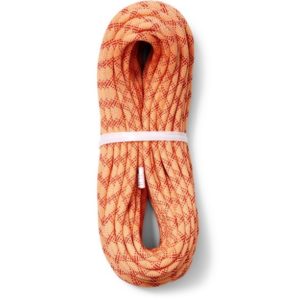
The next choice in the thick climbing rope category was too close to call between these two ropes.
- BlueWater Eliminator Standard 10.2 mm x 60 m rope
- Mammut Crag Classic 10.2mm x 60m Non-Dry Rope
Both of these ropes have average elongation and are rated for a high number of UIAA falls.
Best climbing rope for sport and trad climbing
If you’re going to climb outside, it’s recommended to narrow your search to rope diameters from 9.5 mm to 9.9 mm. Climbing ropes in this medium-diameter category generally give you the best balance of lightweight performance and long life durability. Additionally, many lead climbers—sport or trad—prefer ropes in this range because they can be used in almost any climbing discipline. For top-roping, though, you would likely want something just a little thicker.
Of course there are many important factors to consider other than just the climbing rope diameter which makes the process of choosing a rope very complicated. Scroll down to “Climbing rope factors to consider” to learn how we made our selection. Here we save you the time and research by sharing our top recommendations.
Top Sport Climbing Rope Choice
Edelrid Tommy Caldwell Pro DuoTec 9.6 mm dry rope
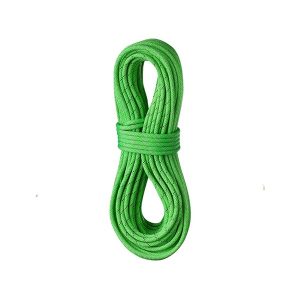
Top Trad Climbing Choice
Beal Booster 9.7 mm Dry Rope
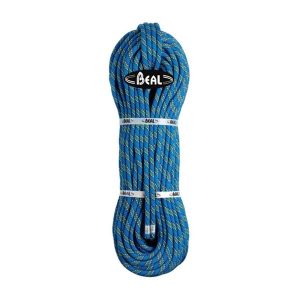
Best climbing rope for high-performance sport and trad climbing
For climbers on multi-pitch or all-day alpine epics, the weight of the rope becomes much more important. Additionally, some sport climbers attempt their hardest routes with a thin rope due to its light weight. On the downside, these ropes are not as durable as greater width ropes; they typically have a shorter lifespan and you don’t want to use a thin rope for top-roping! Top-roping will wear out these ropes too quickly and some light weight ropes have more stretch. The larger stretch means that if a top rope climber falls while still low on the climb the climber may land on the ground before the rope has stretched enough to stop their fall.
We group climbing ropes with diameters 9.5 mm and under to be in the high-performance category.
CAUTION! When using small diameter ropes check that your belay device is compatible with the diameter of rope you have chosen. For example, the Grigri 2 is optimized for rope diameters from 9.4 mm to 10.3 going outside of this range means the device will not operate normally. Petzl cautions that the smallest diameter useable for the Grigri 2 is 8.9 mm. If you are using a rope with a diameter smaller than 8.9 mm you will need to use a different belay device.
Similar to rope used for regular use there are several factors to consider and many rope options available. Here we list our top two recommendations. Scroll down to “Climbing rope factors to consider” to learn how we made our selection.
Top twin/half climbing rope
At 8.1 mm diameter and only 42 grams/meter, the Trango Amphibian 8.1 mm x 60 m rope is a great choice when using the twin or half rope climbing method. The Trango Amphibian has achieved a UIAA number of falls rating of 8 which is still above the average of 7 falls for all 49 ropes evaluated. This is a remarkable level of performance for such a skinny rope.
CAUTION! The 8.1 mm diameter is below the minimum rope diameter for most assisted braking belay devices. You will need to check your belay device to know if this rope is compatible. Fortunately, Black Diamond’s classic ATC-XP Belay Device can handle ropes down to 7.7 mm in diameter.
Trango Amphibian 8.1 mm x 60 m
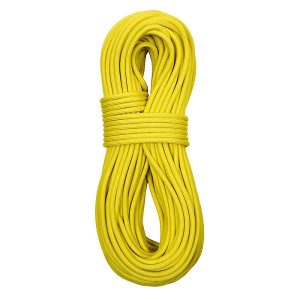
Moja Gear’s best climbing rope evaluation criteria
The following factors were evaluated to determine which ropes to recommend in each category.
1. Rope Length
We recommend going for the 70-meter length climbing rope as a standard. In the past 60 meter length was the standard but nowadays the 70-meter rope has become more popular. The last thing you want at the crag is looking up at a 100 foot (30.5 m) climb trying to remember if your rope is 60 or 70 meters long. Unless you know that the 60-meter length is adequate for climbs in your area, go for the 70-meter length climbing rope.
2. Middle marks and bi-pattern ropes
A middle mark helps you identify the center of the rope, which has various applications and is especially helpful when rappelling. One of the most common mistakes reported in climbing accident reports is that the climber rappelled without having both ends of their rope on the ground. Seeing the midpoint of the rope helps the climber center their rope at the anchor of a climb and reduce the risk of being suspended in the air without a way to get down.
There are three ways the midpoint might be identified:
- In some cases, the middle mark is applied by the manufacturer; the downside is that with time, the middle mark can wear off or become covered in dirt, making it hard to identify.
- Bi-pattern ropes help you quickly identify the midpoint—when the rope’s design pattern/color changes, you’re at the middle of the rope.
- If there is no middle mark, we recommend applying it yourself; Beal makes a rope marker for this purpose. It is not recommended using a marker at home. You can’t guarantee that a marker you have at home isn’t chemically reacting with the sheath on the rope.
Beal Rope Marker
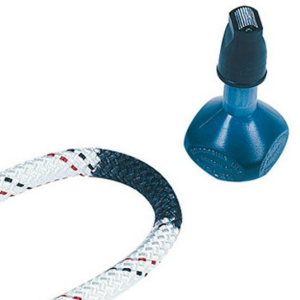
3. Dry treatment and recommendations
A dry treatment helps prevent your climbing rope from absorbing water. This is beneficial on a couple fronts:
- When a rope becomes wet, its strength is reduced, it becomes prone to freezing in alpine environments, and it becomes very heavy.
- A dry treatment can help prevent dirt from entering into a rope’s sheath, therefore increasing its life expectancy.
While dry treatment is a nice benefit to protect your rope and prevent water absorption, it is not required if climbing in a gym and/or in dry outdoor terrain.
4. Percent elongation
When reviewing the technical specifications for climbing ropes you will notice that there are two ratings provided for a climbing rope; static elongation and dynamic elongation.
- Static elongation is a measure of how much a rope will stretch when 80 kg (174 lbs) is loaded on the rope. This 80kg simulates a climber is hanging on the rope. When top-rope climbing, it is nice to have a fairly low elongation number because when a climber hangs on the rope to rest they won’t sink back down the wall very much. For the 49 climbing ropes evaluated here, the average static elongation is 7.5%. So when looking at a rope’s elongation rating you have a perspective on how much the climber will sink down compared to the average ranking. Here Petzl gives a description of the static elongation rating.
- Dynamic elongation is a measure of how much a rope will stretch when an 80 kg (174 lbs) weight experiences a factor-1.7 fall. This is an extreme amount of fall and should always be avoided. Learn more about factor falls from Petzl. The elongation is always much higher than the static elongation because a fall applies a much higher force to the rope than a climber just hanging on the rope. The average rope evaluated here has a dynamic elongation of 32%. A higher elongation number can be dangerous when starting a top rope climb or taking a fall from the 2nd bolt of a sport route though because if the rope stretches a lot the rope might not arrest the fall before the climber hits the ground. Although a higher elongation generally means the climber will experience a gentler fall as the rope takes more distance to arrest (stop) the fall. Just as the climber experiences a lower force to stop their fall so does the bolt or trad protection placed on the wall. In this case, reducing the force on the protection is very helpful. This is quantified by the Impact force rating described below.
5. Impact force rating
The impact force rating is a comparison between climbing ropes quantifying how much force is applied to the bolt or protection on the wall to arrest (stop) a fall. Therefore, a lower number is better. Especially when trad climbing. A lower impact force rating means that for a given fall the protection will experience lower forces. This reduces the chances of the protection being damaged or from coming dislodged from the wall.
The test for Impact is the same test used for dynamic elongation. An 80 kg (174 lbs) weight is dropped for a 1.7-factor fall. The force is measured and reported as the impact force rating. According to Petzl the maximum allowable impact force for a climbing rope is 12kN. Petzl reports that the 12kN limit came from military testing as the highest load the body can handle.
6. Number of UIAA falls
The number of UIAA falls is a measure of how many times a rope can take a large fall and still be useable. The same test is used as the dynamic elongation test. 80 kg weight with a factor 1.7 fall on the rope. This time the test is repeated until the rope breaks. Many novice climbers think this is how many times you can fall on your rope when top-roping or lead climbing. This is not true! The UIAA rating is a measure of how many times the rope can take a very large fall. Here Sterling Rope explains what the UIAA fall rating really means.
Other important information on Climbing Ropes
Types of climbing ropes
Now we’re getting deeper into the world of climbing ropes. There are three main types: single, double, and twin.
- Single ropes: These are the standard climbing ropes that you use at the gym, which you will likely use for the vast majority of your climbs. All ropes recommended on this page are single ropes and widths are generally 8.9mm-10.2mm.
- Double ropes: As the name implies, this is a two-rope system where the climber is tied into both ropes and clips into protection with either rope. This helps to reduce rope drag on winding routes.
- Twin ropes: Like double ropes, this is a two-rope system in which the climber clips both climbing ropes to every piece of protection. Using two ropes allows for faster rappelling and it prevents the horrifying possibility of a rope being cut over a sharp edge.
Static vs. dynamic ropes
Ropes used in climbing applications are either static or dynamic and feature a kernmantle construction—a nylon interior core, or kern, and a woven outer sheath, its mantle.
- Dynamic ropes: These ropes have give or stretchiness to help absorb the impact of a falling climber. Percent elongation, discussed above, is how this stretchiness is measured. Even for top-roping, a dynamic rope is essential to prevent excessive (and dangerous) impact on the climber. Every rope recommended on this page is dynamic.
- Static ropes: Best suited for big wall scenarios (like those pictures of climbers sleeping on the walls of Yosemite!). They are generally used to haul loads or to set up a fixed line … not for the actual climbing. Some people use static ropes for creating top-rope anchors and for rappelling as well.
Want more? Get our awesome climbing newsletter, delivered weekly.
Explore More
Related articles you'll loveFree Rock Climbing eBooks on Technique, Knots, Training, and More
Gear Guide: Sport Climbing Essentials
Everything You Need to Know About Climbing Ropes
How to Clean a Dirty Climbing Rope
Gear Guide: Best Climbing Equipment for Beginners
6 Best Training Recovery Tools for Climbers
Our 30+ most popular articles ever
Community Discussion: Most Popular Climbing Shoes
23 Best Gifts for Rock Climbers
Get daily content updates by Liking us on Facebook

